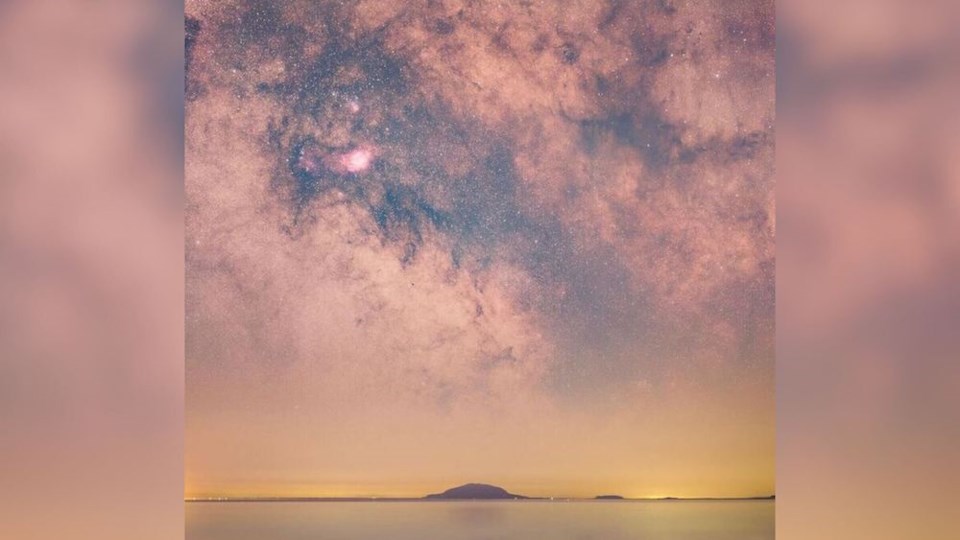Do you enjoy stargazing? What about galaxy-gazing?
A local photographer with a knack for capturing deep space snaps near popular Metro Ā鶹“«Ć½Ó³»landmarks has captured an awe-inspiring image of the hazy Milky Way glowing over Boundary Bay.
Liron Gertsman is a 20-year-old deep space enthusiast who revels in revealing the glittering constellations lost in the expansive dark above us. And while he has taken striking deep space snaps in less light-polluted areas outside of city limits, his determination to capture a unique perspective over a popular Ā鶹“«Ć½Ó³»sight recently landed him a feature by NASA as its "Astronomy Image of the Day."
Back in January, Ā鶹“«Ć½Ó³» featured the jaw-dropping photograph of two nebulae glowing vibrantly above The Lions--known as the Two Sisters or Ch'ich'iyúy Elxwíkn, in the Squamish language.
The spellbinding snap features the , in several shades of pink and red.
Now, the successful young astrophotographer has captured a dazzling perspective of the Milky Way galaxy.
Milky Way over Boundary Bay
Gertsman took to Instagram to share an image of the Milky Way that he captured on the first night of June. He commented that viewing conditions were ideal without "a cloud in the sky," which allowed him to attempt the image.
"By framing our galaxy's core (at 100mm) over Lummi Island, a small but relatively tall island located over 40 kilometers (25 miles) south across the US/Canada border, I hoped to give a sense of the massive scale of space relative to land here on Earth," he wrote.
While he was 40 minutes away from Vancouver, Gertsman noted that light pollution from the city was still significant. To overcome it, he used long exposure and stacking techniques. "This final image integrates 72 stacked images totalling 35 minutes of exposure time, helping to reduce noise and increase detail."
In the final image, "the glow of cities in Washington state remains visible on the horizon." Gertsman said he wanted to leave the "light pollution colour cast created by sodium-vapor lamps in nearby cities in the final image, resulting in warm colour tones."
The final "deepscape" image is an "alignment captured over the course of an hour or so, with the long-exposure images of the sky taken using a star-tracker (to counter the rotation of the earth), and the corresponding foreground images taken with the tracker turned off," he explained.
When some fog rolled in from nearby fields, Gertman had to move locations mid-shoot, so not all images were taken from the exact same spot.
As the nights get shorter heading into summer, we "will no longer get entirely dark at this latitude," he notes. But since there are many clear nights, "stargazing is still a fantastic activity."
'Once-in-a-lifetime' photo of rare comet and Northern Lights in B.C.
In July 2020, Gertsman shared another remarkable image of a rare comet and Aurora Borealis at Harrison Lake.
The Neowise comet, discovered in March by NASA’s Neowise infrared space telescope, reached its closest point to the sun on July 3, which caused the “frozen ice ball” to heat up and burn gas and dust off its surface.
Back then, Gertsman told V.I.A. that he had never had the opportunity to shoot a comet before. The last comet visible from the northern hemisphere that was comparable to Neowise was Comet Hale–Bopp in 1997, which was before he was born.
When asked what originally inspired him to learn more about deep space, Gertsman said he was in grade eight at Point Grey Secondary School when he had his first "wow moment."
"I had a science teacher who did a unit on space. His name is John Procyk and he actually went on to win the Prime Minister's Award for Teaching Excellence," he said.
"But I really started to explore, you know, what does it take photograph a night sky. Over the years that passion has grown and grown. I would also say with the Internet there are so many incredible resources available online."
Aside from watching tutorials, reading articles and looking at other astrophotographers for inspiration, Gertsman said many of his techniques and knowledge come from practice and experiments.
Follow Gertsman on or check out his photography on his .


